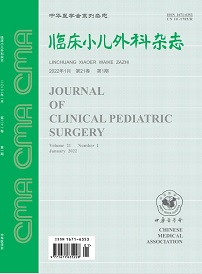Qi Siyu,Ge Yucheng,Zhao Zhenqiang,et al.Clinical phenotypic analysis of primary hyperoxaluria and nephrolithiasis-related gene mutation-negative children[J].Journal of Clinical Pediatric Surgery,,():7-12.[doi:10.3760/cma.j.cn101785-202410010-002]
Clinical phenotypic analysis of primary hyperoxaluria and nephrolithiasis-related gene mutation-negative children
- Keywords:
- Hyperoxaluria; Primary; Nephrolithiasis; Surgical Procedures; Operative; Child
- Abstract:
- Objective To explore the clinical characteristics of primary hyperoxaluria (PH) and nephrolithiasis-related gene mutation-negative children. Methods A retrospective analysis was conducted for the relevant clinical data of 82 children with nephrolithiasis treated at Beijing Friendship Hospital,Capital Medical University,between May 2016 and October 2024.They were assigned into two groups of PH (n=54) and nephrolithiasis-related gene mutation-negative (n=28).The PH group was divided into 3 groups according to different types of gene mutation,which were PH1 group (AGXT gene mutation,n=22), PH2 group (GRHPR gene mutation,n=9)and PH3 group (HOGA1 gene mutation,n=23).The incidence of nephrocalcinosis,serum creatinine concentration and urinary metabolism clinical characteristics were recorded. Results As compared with nephrolithiasis-related gene mutation-negative individuals,PH children were more prone to nephrocalcinosis (26/54 vs.0/28,P<0.001).Additionally,PH children had higher serum creatinine levels [42.35(32.43,54.65) vs.34.00 μmol/L,P=0.007) and urinary oxalate/creatinine ratios but lower urinary calcium levels than nephrolithiasis-related gene mutation-negative counterparts.Among PH subtypes,PH3 individuals exhibited milder clinical phenotypes as compared with PH1/PH2 counterparts.PH3 individuals had the lowest incidence of nephrocalcinosis (4/23 vs.19/22 vs.3/9,P<0.001,PH3 vs.PH1 vs.PH2),the lowest serum creatinine [32.80(29.50,43.85) vs.48.62(41.55,74.26) vs.49.22(36.28,65.51) μmol/L,P=0.006]and the highest urinary calcium/creatinine ratio [113.27(49.56,237.17) vs.53.10(26.56,115.05) vs.54.87(12.39,107.97) μg/mg,P=0.043).No statistically significant differences existed in urinary oxalate/creatinine ratios among PH subtypes. Conclusions The clinical manifestations of PH children were more severe than gene mutation-negative counterparts.And PH3 individuals have milder clinical phenotypes as compared with PH1/PH2 counterparts.
References:
[1] Zhao YN, Fang XL, Fan YJ, et al.Integration of exome sequencing and metabolic evaluation for the diagnosis of children with urolithiasis[J]. World J Urol, 2021, 39(7):2759-2765.DOI:10.1007/s00345-020-03449-9.
[2] Zhao FZ, Li J, Tang L, et al.Characteristics of the genotype and phenotype in Chinese primary hyperoxaluria type 1 populations[J]. Urolithiasis, 2021, 49(1):17-25.DOI:10.1007/s00240-020-01201-x.
[3] Shee K, Stoller ML.Perspectives in primary hyperoxaluria:historical, current and future clinical interventions[J]. Nat Rev Urol, 2022, 19(3):137-146.DOI:10.1038/s41585-021-00543-4.
[4] Metry EL, Garrelfs SF, Deesker LJ, et al.Determinants of kidney failure in primary hyperoxaluria type 1:findings of the European hyperoxaluria consortium[J]. Kidney Int Rep, 2023, 8(10):2029-2042.DOI:10.1016/j.ekir.2023.07.025.
[5] Cai ZT, Ding M, Chen RG, et al.Primary hyperoxaluria diagnosed after kidney transplantation:a case report and literature review[J]. BMC Nephrol, 2021, 22(1):393.DOI:10.1186/s12882-021-02546-0.
[6] Cochat P, Rumsby G.Primary hyperoxaluria[J]. N Engl J Med, 2013, 369(7):649-658.DOI:10.1056/NEJMra1301564.
[7] Wu JY, Song J, He YZ, et al.Case series and literature review of primary hyperoxaluria type 1 in Chinese patients[J]. Urolithiasis, 2023, 51(1):123.DOI:10.1007/s00240-023-01494-8.
[8] Ge YC, Liu YK, Zhan RC, et al.HOGA1 variants in Chinese patients with primary hyperoxaluria type 3:genetic features and genotype-phenotype relationships[J]. World J Urol, 2023, 41(8):2141-2148.DOI:10.1007/s00345-023-04461-5.
[9] Liu YK, Zhao ZQ, Ge YC, et al.Clinical features and mutational spectrum of Chinese patients with primary hyperoxaluria type 2[J]. Urolithiasis, 2024, 52(1):74.DOI:10.1007/s00240-024-01579-y.
[10] Cornell LD, Amer H, Viehman JK, et al.Posttransplant recurrence of calcium oxalate crystals in patients with primary hyperoxaluria:incidence, risk factors, and effect on renal allograft function[J]. Am J Transplant, 2022, 22(1):85-95.DOI:10.1111/ajt.16732.
[11] Michael M, Harvey E, Milliner DS, et al.Diagnosis and management of primary hyperoxalurias:best practices[J]. Pediatr Nephrol, 2024, 39(11):3143-3155.DOI:10.1007/s00467-024-06328-2.
[12] Shah RJ, Vaughan LE, Enders FT, et al.Plasma oxalate as a predictor of kidney function decline in a primary hyperoxaluria cohort[J]. Int J Mol Sci, 2020, 21(10):3608.DOI:10.3390/ijms21103608.
[13] Singh P, Viehman JK, Mehta RA, et al.Clinical characterization of primary hyperoxaluria type 3 in comparison with types 1 and 2[J]. Nephrol Dial Transplant, 2022, 37(5):869-875.DOI:10.1093/ndt/gfab027.
[14] Arnous MG, Vaughan L, Mehta RA, et al.Characterization of stone events in patients with type 3 primary hyperoxaluria[J]. J Urol, 2023, 209(6):1141-1150.DOI:10.1097/ju.0000000000003400.
[15] Sas DJ, Mara K, Mehta RA, et al.Natural history of urine and plasma oxalate in children with primary hyperoxaluria type 1[J]. Pediatr Nephrol, 2024, 39(1):141-148.DOI:10.1007/s00467-023-06074-x.
[16] Martin-Higueras C, Garrelfs SF, Groothoff JW, et al.A report from the European Hyperoxaluria Consortium (OxalEurope) Registry on a large cohort of patients with primary hyperoxaluria type 3[J]. Kidney Int, 2021, 100(3):621-635.DOI:10.1016/j.kint.2021.03.031.
[17] Ge YC, Liu YK, Zhan RC, et al.Genotype and phenotype characteristics of Chinese pediatric patients with primary hyperoxaluria[J]. Hum Mutat, 2023, 2023:4875680.DOI:10.1155/2023/4875680.
[18] Gupta A, Somers MJG, Baum MA.Treatment of primary hyperoxaluria type 1[J]. Clin Kidney J, 2022, 15 (Suppl 1):i9-i13.DOI:10.1093/ckj/sfab232.
[19] Gang X, Liu F, Mao JH.Lumasiran for primary hyperoxaluria type 1:What we have learned?[J]. Front Pediatr, 2022, 10:1052625.DOI:10.3389/fped.2022.1052625.
[20] Goldfarb DS, Lieske JC, Groothoff J, et al.Nedosiran in primary hyperoxaluria subtype 3:results from a phase I, single-dose study (PHYOX4)[J]. Urolithiasis, 2023, 51(1):80.DOI:10.1007/s00240-023-01453-3.
Memo
收稿日期:2024-10-8。
基金项目:北京市医院管理中心临床技术创新项目(XMLX202101)
通讯作者:王文营,Email:miniaowwy@aliyun.com
